Mathias & R.E. Chapman Chinchilla Research

(above) A field of bunch grass growing on the Altiplano Plateau of Chile - origin of the wild chinchilla
Chapman Chinchilla Research
attr. to Mathias & Reginald Chapman circa 1930-1945
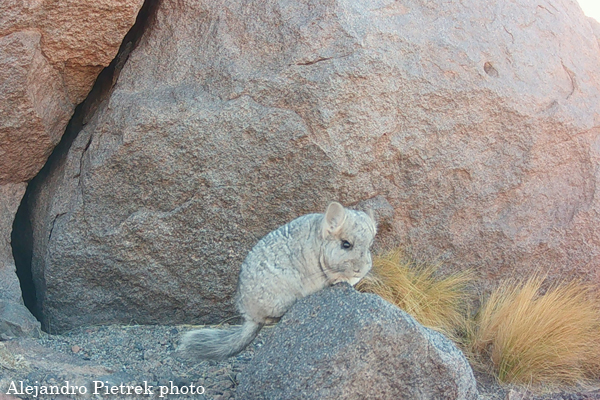 The first chinchillas to arrive in the United States were imported from Chile by Mr. Mathias Chapman in 1923. With this small group of wild caught chinchillas, he established the world's first successful domestic breeding herd. Subsequently, Chapman Chinchilla drafted what is perhaps the earliest surviving research study of the domestic chinchilla. This historic account is being published in four parts during the winter of 2024-2025.
The first chinchillas to arrive in the United States were imported from Chile by Mr. Mathias Chapman in 1923. With this small group of wild caught chinchillas, he established the world's first successful domestic breeding herd. Subsequently, Chapman Chinchilla drafted what is perhaps the earliest surviving research study of the domestic chinchilla. This historic account is being published in four parts during the winter of 2024-2025.
Please Note: Chapman's research was conducted close to a century ago, and is being published for its historic value. It is not intended to offer modern medical or management advice. Some of the medications or therapies described by Chapman Chinchilla Research are no longer used today. Please check with a licensed veterinarian before treating your chinchilla. As such, Chapman's insight into chinchilla health and husbandry is deserving of much respect, especially in light of the relatively primitive diagnostics and technologies available to him at the time. Images added independently of Chapman Chinchilla Research.
(pictured) A wild short-tailed Chinchilla chinchilla -photo cr. Alejandro Pietrek, Argentina
Part 1 of 4
Published December 7, 2024
CHAPMAN CHINCHILLA RESEARCH
1831½ W. Imperial Highway
Los Angeles 47, California Phone: PLymouth 5-1558
MEDICATIONS FOR CHINCHILLAS
"For the past ten years the CHAPMAN CHINCHILLA RESEARCH laboratory has been actively engaged in the study of the chinchilla and has devoted itself to the detection, prevention, and control of disease characteristics [of] the chinchilla. During this period certain products and methods of treatment have been developed which have consistently proven to be successful in the battle against disease. Because the laboratory has devoted itself to the chinchilla industry as a whole in its efforts to promote research on the chinchilla it is believed that information obtained through its efforts should be made available to all breeders. With this purpose in mind, it is hoped that the following information will be of value to breeders everywhere and to the industry to which we are devoted."
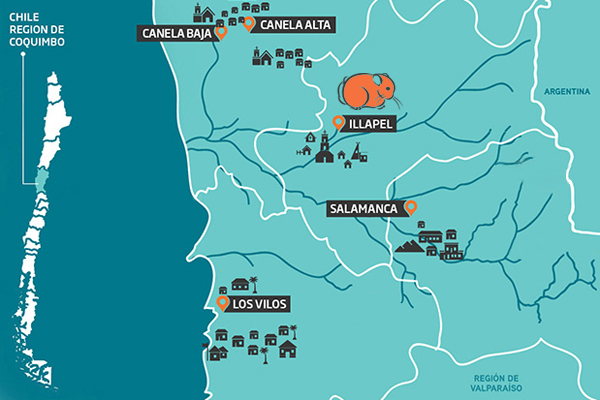 (map) The Coquimbo Region of Chile, origin of the short tailed Chinchilla chinchilla, and long tailed Chinchilla lanigera
(map) The Coquimbo Region of Chile, origin of the short tailed Chinchilla chinchilla, and long tailed Chinchilla lanigera
We have chosen for our first topic of discussion “Medications for Chinchillas.” This topic has been chosen for primary consideration because a great number of animals have been lost due to the fact that they were “doctored” when no treatment was needed or because they received the wrong treatment.
Wonder drugs have played a very important part in modern medicine when used discriminately. However, like every other medicine, these may act as poisons if used improperly. Many people are of the opinion, as the name indicated, that these drugs will do wonders and at the first sign of an abnormal action "WONDER DRUGS" are stuffed down the animal[s'] throats. These drugs when used in this manner have caused more damage than if the animals had received no treatment.
Wonder drugs when given orally have different reactions. The sulfas will retard or even stop the peristaltic movement of the intestinal tract and thereby cause an impaction of the caecum and lower bowel. In addition these drugs not only kill harmful bacteria, but the entire bacterial population of the intestinal tract. It is necessary for all animals to possess some bacteria in their intestinal tracts as the “natural flora” is responsible for the synthesis of many vitamins. Chinchillas like all herbivorous animals must possess certain bacteria which are capable of breaking down cellulosic products into simpler products or units which can be converted into energy or building blocks. There cellulose decomposing bacteria which are inhabitants of the caecum are also among those destroyed when “WONDER DRUGS” are given orally. It is not hard to imagine what happens when this takes place –IMPACTION.
The sulfa drugs are not the only responsible agents, but also any antibiotic such as penicillin, streptomycin, aureomycin, etc. when given orally. This probably brings up the question in a lot of people’s minds - - just how and when should the “WONDER DRUGS” be used?
The antibiotic to be used is dependent on the physiology of the bacteria present. Generally, it is necessary for the qualified bacteriological laboratory to determine the specific bacterial species and the antibiotic that will be effective against it. Usually, pneumonias are caused by a group of microorganisms which are susceptible to penicillin therapy. The dosage is determined by the age of the animal: 50,000 units per cc. minimum and 100,000 units per cc. maximum for animals over 60 days of age. The intervals between injections of penicillin depends on the type of penicillin used.
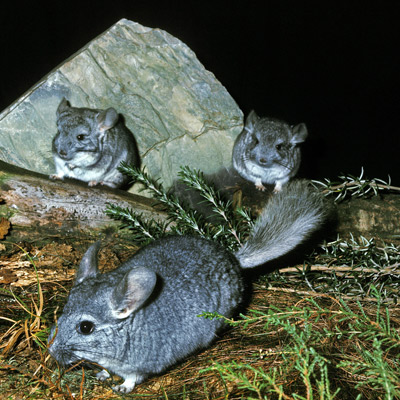 (right) Chilean Chinchilla lanigera
(right) Chilean Chinchilla lanigera
Most enteritis [is] caused by different species of bacteria which are susceptible to streptomycin therapy. Dosage is very important in using streptomycin because of its high toxicity to chinchillas. We have found that 10 milligrams per day is adequate to control these infections, but even then, this should be one of the last resorts because most diarrheas may be traced back to dietary problems. Those that are not dietary in nature may usually be controlled by a strict vaccination program which renders the animals immune to specific infections – Pseudomonas and Salmonella. Dietary diarrheas may be controlled by changing the different components of the diet in order to find exactly which part of the diet is causing the trouble. That component is then eliminated until the animal has adjusted itself and is once again able to return to its regular diet.
Another preparation which is by no means a “WONDER DRUG”, but works a lot letter than “WONDER DRUGS” on non-specific diarrheas is PABLUM, the prepared baby food. Pablum may be given along with pellets and nothing else at the first sign of looseness. If this does not curb the soft droppings, it is usually a more serious condition that requires professional help.
The sulfa drugs should play a very small part in the internal treatment of chinchillas because of their high toxic properties. As a result sulfa drugs should not be used unless there is no other medication that can control the specific infection or infections. These recommendations may be given by any qualified laboratory doing the diagnostic work and passed on to a qualified veterinarian who will direct treatment.
The external use of sulfa drugs is not as complicated as when given internally and therefore, the average breeder may use these preparations in his daily doctoring. The sulfa of choice in this case if sulfathiazole, either powder or 5% ointment.
ATABRINE: (When, why, and how to Use:)
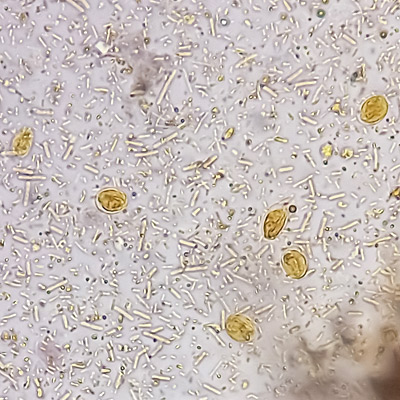 (left) Giardia lamblia cysts under 40x light microscope
(left) Giardia lamblia cysts under 40x light microscope
This brings up another problem. What about Atabrine? Should it be given at the first sign of looseness or just what is the proper procedure to follow? We have found that is it advisable to give atabrine only when the animal is known to be infested with Giardia. >The only way to tell if the animal is infested is to examine the droppings for the Giardia cyst using a microscope. The protozoan, Giardia, as you may know, has two phases: The motile trophozoite state and the non-motile resistant stage or cyst form. The trophozoite state is rarely present in the droppings as the protozoan attaches itself to the wall of the small intestine by means of two suction discs. It does not invade the walls, but merely hangs on getting its energy from the intestinal mucosa. When the trophozoites are released from the wall for reproduction purposes it encysts or is encased in a resistant covering. This is the phase that is found in the droppings. Naturally when other animals eat or lick these infected droppings (all caged animals do this) they, too, become infected with the disease. The cyst breaks out of its protective coat and the trophozoite attaches itself itself to the lining of the new host’s intestine where it multiplies and starts the cycle over again. The diarrhea that is common to Giardiasis is due to the large number of trophozoites that are lining the wall of the intestine. Nature tries to eliminate these by flushing them out which actually is a mechanical obstruction of water absorption.
Many remedies have been tried to free the animal of these intestinal protozoans, but the only one we have found that accomplishes this is Atabrine. Atabrine must be used discriminately or the metabolism of the animal will be inhibited. This may be overcome by adding riboflavin, a B vitamin, which is essential in the energy metabolism of the animal. We now mix Atabrine with a commercial Vitamin B complex so that each cubic centimeter contains 10 milligrams of atabrine. Ten milligrams of atabrine or one dropperful of the mixture is given to the animal for four days when it is found to be infested with Giardia.
Please Note: Chapman's research was conducted close to a century ago, and is being published for its historic value. This publication is not intended to offer modern medical or management advice.
Part 2 of 4
Published January 17, 2025
CHAPMAN CHINCHILLA RESEARCH
1831½ W. Imperial Highway
Los Angeles 47, California Phone: PLymouth 5-1558
DIET

(right) Andean Highland Puna Grasslands Ecoregion, of the Montane Grasslands and Shrublands Biome
A. The diet should be as simple as possible for several reasons.
1. The animal in its natural habitat did not have as rich a diet as are given most animals.
2. Too rich a diet can be responsible for the animal becoming fat.
a. A fat animal is regarded by some people as inferior because of its decreased durability.
b. The chinchilla is susceptible to the disease of the liver known as “fatty generation.”
c. A fat animal has a lower resistance than an animal of normal weight.
d. A fat animal is usually a very poor producer.
3. Treats, such as raisins, prunes, and apples are not advisable because of their high sugar content and they can be responsible for looseness which can be rather hard to check. The animals actually do not need them as most pellets are more than sufficient for their needs.
4. Do not change your diet unless there is very good reason, and if a change is necessary it should be done slowly over a period of about a month.
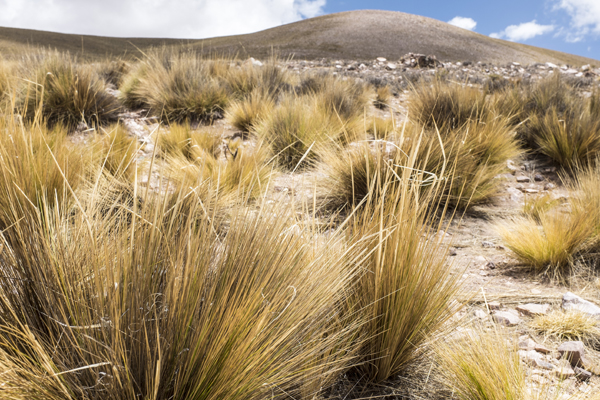 (left) Bunch grass, a dietary staple of the wild chinchilla, Andes Altipano desert, Chile
(left) Bunch grass, a dietary staple of the wild chinchilla, Andes Altipano desert, Chile
B. The following precautions should be followed when hay is purchased.
1. There are at least four kinds of hay being fed to chinchillas. Alfalfa, bean straw, timothy, and prairie hay. We have found that bean straw is probably the most consistent as far as quality is concerned, however the others are all being fed with good success by ranchers.
2. Is the storage place at the dealers and at your ranch free from vermin such as rats and mice, or do they have free access to it?
3. Is the hay sprayed with any kind of insecticide that may harm the animals? Some alfalfa is sprayed with 5% cholrodane and the chinchilla can tolerate only about ½%.
4. Is the hay clean or is it filled with pieces of trash such as paper, sticks, etc.? It is also advisable to make sure that the alfalfa you purchase is not too leafy as that can cause looseness.
5. Dehydrated hays are usually free of disease vectors, but the heat can destroy many vitamins and change the proteins to the point they may be harmful to animals.
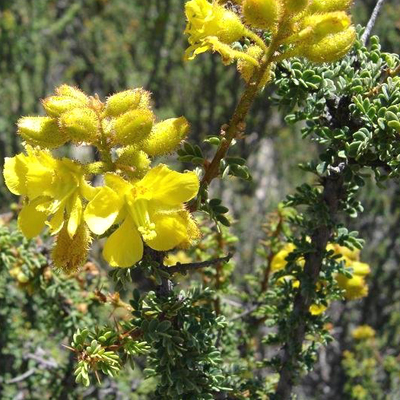 (right) Algarrobilla (Balsamocarpon brevifolium), a shrub high in tannins, is a component of the chinchillas' native diet
(right) Algarrobilla (Balsamocarpon brevifolium), a shrub high in tannins, is a component of the chinchillas' native diet
-Ricardo Martini photo
C. Supplementary Feeding.
1. This should be fed only to those animals known to be in a run down condition. If it is fed to all the animals, some animals will be overfed.
2. If the supplementary feed it used, it should be stored properly.
a. If it contains wheat germ, it should be made in very small batches using fresh wheat germ and stored in the refrigerator, since wheat germ can go rancid with very harmful results to the animals.
D. Conclusion: We recommend that a diet should be as simple as possible and yet fulfill your needs. We have found that a diet consisting of all the pellets (recommended) it will consume in 24 hours, and all the roughage (bean straw) the animal will eat is very satisfactory.
Please Note: Chapman's research was conducted close to a century ago, and is being published for its historic value. This publication is not intended to offer modern medical or management advice.
Part 3 of 4
Published February 19, 2025
CHAPMAN CHINCHILLA RESEARCH
1831½ W. Imperial Highway
Los Angeles 47, California Phone: PLymouth 5-1558
COMMON DISEASES OF THE CHINCHILLA
A. Giardia
(below) Giardia lamblia, an anaerobic flagellated protozoan, in trophozoite form
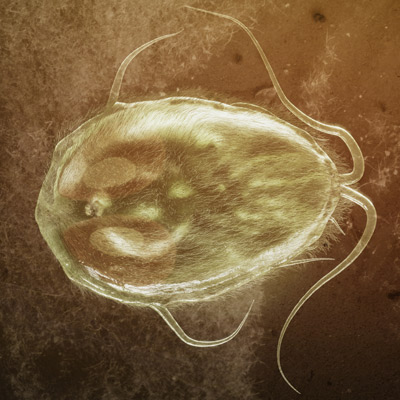 1. This is a Protozoan parasite that attaches itself to the small intestine of the animal by two suction discs. It does not have the power to invade the tissue, but merely runs the animal down with the occasional diarrhea it causes.
1. This is a Protozoan parasite that attaches itself to the small intestine of the animal by two suction discs. It does not have the power to invade the tissue, but merely runs the animal down with the occasional diarrhea it causes.
2. It is diagnosed by checking the droppings for the resistant reproduction stage or cyst.
3. It should not be treated with the medication (Atabrine) unless it is certain the animals are known to be infested with the parasite. Atabrine stops the utilization of Riboflavin which goes into the ma[k]e up of the coenzymes I & II which makes it possible for the animal to derive its energy from foodstuffs.
4. Giardia is one of the most common causes of trouble in many herds, and should be re[c]ognized as a disease.
5. Some of the symptoms of Giardia are:
a. Dark sticky droppings.
b. Sudden and very severe diarrhea with death in a few hours.
c. Fur slippage in some cases.
B. Pseudomonas aeruginosa
1. One of the greatest killers of chinchillas.
2. It manifests itself in many ways, and can be either a localized or generalized infection.
a. It can cause eye infections.
b. External lesions on the skin.
c. Ear infections.
d. It can attach any and all internal organs.
3. It can be controlled by regular immunization.
C. Proteus [mirabilis]
1. The organism Proteus is part of the normal bacterial population in the intestine of the [c]hinchilla and most animals, but it is an opportunist. An opportunist is an organism which is able to take advantage of some special or unusual combination of circumstances (such as weakened condition of the animal) favorable to its development. When this happens the organism leaves its normal habitat and invades the tissues and organs acting as a disease producing bacteria.
2. It is possible to have an autogenous bacterin made against a specific strain, but usually the organism is found and is treated with one of the antibiotics.
3. If it is found in bacteriological culture of a dropping, it does not necessarily mean the animal is infected with the organism, but may be normal depending upon the condition of the individual animal. If the animal is in a weakened condition it should be considered as a pathogen and treated as such.
D. Salmonella typhimurium (right) infections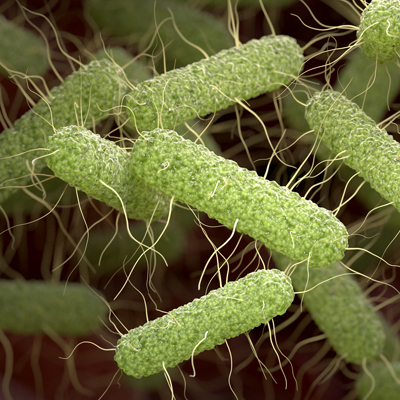
1. This disease is commonly known as typhoid of rodents.
2. It used to be very common in chinchilla herds, but due to immunization it is now very rare. Most of the larger ranchers immunized their herds so that the incidence is reduced. Animals from these herds have some protection, but the immunization will only last so long, unless booster shots are given regularly.
3. Since among most wild rodents the disease is endemic it could break out spontaneously in any herd that is not immunized against it.
4. Once the disease breaks out in an unprotected herd, immunization will help out but some animals will be lost before the antibiotics are produced.
E. Streptococcal infections
1. Streptococci are usually the cause of pneumonia but also can be responsible for septicemias (organisms that grow in the blood stream) which cause them to be carried by the blood and localized at various other points in the body, that is; liver, spleen, bone marrow or lymph glands of the intestine, causing what are called secondary abscesses or secondary foci of infections.
F. Disease of Rodents
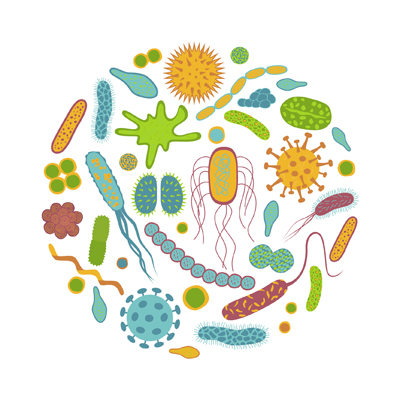 1. The chinchilla being a member of the rodent family is susceptible to the diseases of rodents which can be caused by a great number of organisms among them the Pasteurellas.
1. The chinchilla being a member of the rodent family is susceptible to the diseases of rodents which can be caused by a great number of organisms among them the Pasteurellas.
2. It is very important that you have all losses posted to make sure that your herd has not become infected with a disease that is common among wild rodent population. If you wait until you lose several animals before having them posted, it may be too late to save the others. Since the rodent diseases that occasionally arise are rare, much more work is required for positive identification, usually a week to 10 days. A great number of animals could be lost before the results were known, if you were to wait until the losses were occuring regularly.
G. CONCLUSION: The chinchilla is not the disease free animal that many people have been led to believe. Like any other living thing, there are some diseases to which they are susceptible and it is best to be prepared to fight them. If you let someone help you that has had experience with disease diagnosing, combating and preventing, you will save yourself a lot of money, headaches, and animals. Know what you are treating before you treat. Don't let another rancher try to diagnose your trouble by comparing it to some trouble he has had in the past. The trouble he had may be entirely different, and before you actually find out what the cause of your trouble is, you have lost a great many animals.
Please Note: Chapman's research was conducted close to a century ago, and is being published for its historic value. This publication is not intended to offer modern medical or management advice.
Part 4 of 4
Published March 15, 2025
CHAPMAN CHINCHILLA RESEARCH
1831½ W. Imperial Highway
Los Angeles 47, California Phone: PLymouth 5-1558
GENERAL RANCH ROUTINE
A. The sanitation of equipment used is extremely important.
 1. The drinker bottles should all be washed at least once a week since the bacteria Pseudomonas aeruginosa has as its normal habitat stagnant waters.
1. The drinker bottles should all be washed at least once a week since the bacteria Pseudomonas aeruginosa has as its normal habitat stagnant waters.
a. This can be accomplished best by first washing the bottles with a detergent such as "Tide, Dreft, Surf" etc. Following this the bottles should be rinsed in a quaterinary ammonia product such as "Roccal".
2. If dew drop watering systems are in use, they should be flushed at least once a week.
3. The pens, if possible should be scrubbed at least once a month. Since most diseases are spread by the droppings it is obvious how important clean pens are.
4. The feed hoppers or dishes should be emptied everyday and the old feed replaced by new.
5. The pens and units should be swept out everyday. If possible a whisk broom should be used only on one pen, each having its own. If this is impractical, no brush should be used on a soft animal and then on one that is normal. The brush should first be washed in "Roccal" and allowed to dry in the sun before being used again.
B. General precautionary measures that should be followed.
1. All new animals should be isolated from your herd for at least a month. If the animal is infected with any disease, it will usually show up during this period. It is also advisable that the animals be checked to make sure they are not healthy carriers of some disease. This can be checked by having a dropping analysis made by a competent laboratory.
2. All the animals in your herd should be observed daily for any abnormalities.
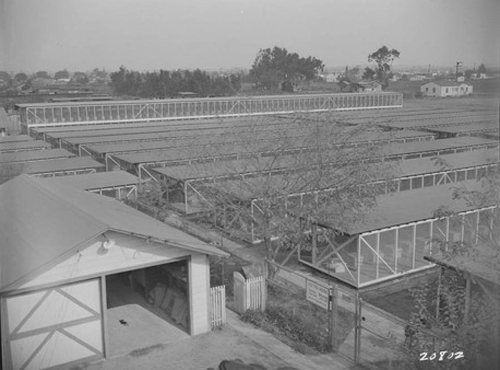 a. The condition of the dropping[s] is usually the first sign of pending trouble.
a. The condition of the dropping[s] is usually the first sign of pending trouble.
1. Soft droppings can be caused by one of two things, dietary or an infection. If a new feed stuff has been introduced, suspect that as being responsible. Take the feed away and see if the condition is alleviated, however, don't wait to see, but at the same time, suspect an infection. Do not do any treating until you know exactly what you are treating. Many treatments are more severe than the disease itself.
The droppings should be sent to a laboratory for an accurate diagnosis. The droppings should be taken as fresh as possible, wrapped in waxed paper, and placed in a vial with a piece of moist cotton. This will keep the droppings moist in case a bacteriological culture should be necessary. Once you know what you are healing with treatment, it is relatively simple.
2. Small and hard, or extremely large and hard droppings usually are in indication of an impaction. The condition should be recognized as such and measures to prevent a complete impaction should be taken. Check your watering system and make sure the animals are getting plenty of water. Then check your diet and make sure you have nothing in it such as pablum or rolled oats that will absorb water. Another common cause of impaction is the administration of antibiotics or sulfa drugs orally.
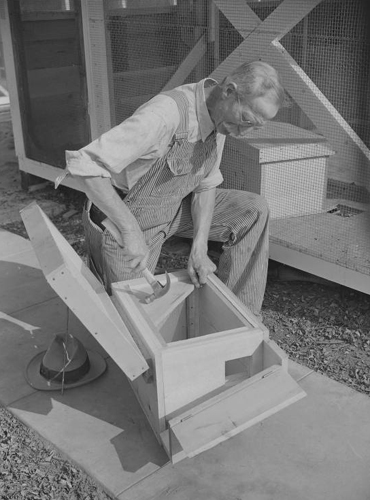 3. You should know your animals well enough so that you know what is to be expected in the way of droppings by the individual animals. Any change should be considered as a sign of pending trouble.
3. You should know your animals well enough so that you know what is to be expected in the way of droppings by the individual animals. Any change should be considered as a sign of pending trouble.
b. The condition of the animals['] eyes should be checked to make sure that they are not suffering from a localized infection. Most infections of the eye are caused by the bacteria Pseudomonas aeruginosa and should be checked before there is a permanent damage to the eye itself. Have a culture made of some of the excretions so that you will know exactly what you are combating.
c. Check the ears to make sure that there is no discharge or the animal is not holding its head to one side. This can be an indication of an ear infection.
d. The condition of the fur should also be checked. If the fur is getting thin or is slipping (not fur chewing), this can indicate a chronic disease such as Giardia which is causing a fever. Over again a check of the dropping[s] will give an insight to the trouble. If there are definite lesions and the fur is coming out, it could indicate that the animal is suffering from a fungus condition. It should be checked by a person that is familiar with the condition before it is treated.
3. Regular immunization cannot be recommended too highly.
a. Fifty percent of the animals showing a bacterial infection when posted by the Chapman Chinchilla Research are infected with Pseudomonas aeruginosa, either as a primary or secondary invader. Many of these animals would be alive today and producing if they had been immunized.
b. Ranchers that immunize regularly have found that the mortality in the herd has been greatly reduced.
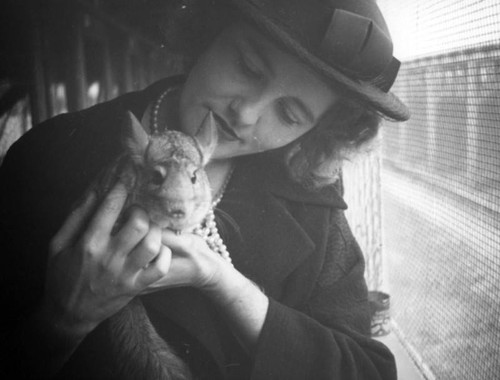 c. If you immunize a healthy herd the antibodies will be present when they are needed to fight the specific disease.
c. If you immunize a healthy herd the antibodies will be present when they are needed to fight the specific disease.
d. Immunization is not a cure but is a preventative as a vaccination in humans. Typhoid shots are given before exposure to disease, and not after the first symptoms.
(pictured) (top-bottom, 1-4)
1. Row of cages at the Chapman Chinchilla Farm, Herman Schultheis photo, circa 1937
2 .Chapman's Chinchilla Farm - General view, Doug White photo, Nov. 1937
3. Chapman's Chinchilla Farm - Building Pen, Doug White photo, Nov. 1937
4. Ethel pets a chinchilla at the Chapman farm, Herman Schultheis photo, circa 1937
CONCLUSION: Sanitation is absolutely necessary if you are to be successful in the raising and breeding of chinchillas. All precautions should be taken to insure a healthy herd. If an animal is abnormal in any respect, have it checked by a competent laboratory or Veterinarian before you start to treat it. Try to prevent trouble before it starts by having your animals immunized against Pseudomonas and Salmonella. Typhoid was one of the largest killers in the United States, but since immunization measures have been taken the incidence is very low.
-THE END-
Regarding the pictures in Part 4 'GENERAL RANCH ROUTINE,' the Chapman Chinchilla Ranch was located in an unusually temperate location. However, chinchillas cannot live outside in most areas. Temperatures above 76 fahrenheit / 24 celsius can put chinchillas at extreme risk of death.
Please Note: Chapman's research was conducted close to a century ago, and is being published for its historic value. This publication is not intended to offer modern medical or management advice.
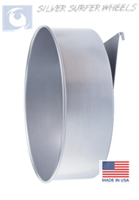 *Interesting Fact: In the early 1940's, Mathias Chapman's son Reginald opened a small factory in Big Bear, California which made exercise wheels for chinchillas (cr Angela Vergara). This was perhaps the first chinchilla exercise wheel ever produced!
*Interesting Fact: In the early 1940's, Mathias Chapman's son Reginald opened a small factory in Big Bear, California which made exercise wheels for chinchillas (cr Angela Vergara). This was perhaps the first chinchilla exercise wheel ever produced!
Read more about Silver Surfer chinchilla exercise wheels, pictured right, manufactured in the USA by Brytin Products... for maximum chinchilla health and happiness!